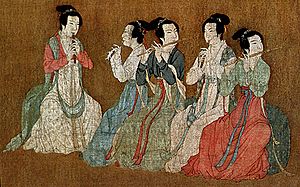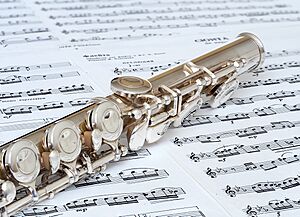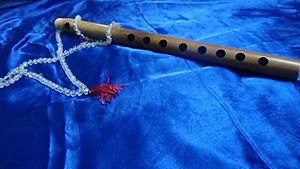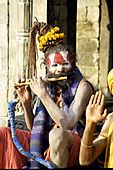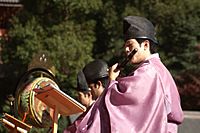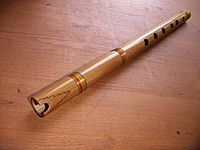Flute facts for kids
The Flute is a beautiful musical instrument that makes sound when air is blown across a hole. The person who plays a flute is called a flautist.
There are many kinds of flutes. The most common one you'll see in a concert is the C tuning flute. Other types include the tiny piccolo, the deeper alto flute, and the very low bass flute.
Contents
The Flute's Journey Through Time

Flutes have a long and interesting history, changing a lot over many centuries. Early flutes, like Pan flutes, were simple pipes joined together. Later, during the Renaissance period, a new type of flute became popular.
In the Baroque music era, the word 'flute' often meant a recorder. So, to avoid confusion, the side-blown flute was called a traverso. A clever flute maker from Bavaria named Boehm made big changes to the flute in the 1800s. He made it louder and easier to play all the different notes of the chromatic scale. These improvements led to the modern flute we know today.
Flutes are used in many types of music. Baroque composers loved them in their orchestras, often using two at a time. They wrote concertos (music for a solo instrument with an orchestra), chamber music (for small groups), and solo pieces for the flute. This tradition continues today. Most orchestras have at least two flutes, and sometimes even three or four! You might also hear a piccolo, which plays an octave higher than the regular flute, or an alto flute, which plays a fifth lower.
The flute can sound very bright and happy when playing high notes. For example, listen to the Badinerie from Bach's Orchestral Suite no 2. But it can also sound thoughtful or even sad when playing its lowest notes. A great example is the beginning of Debussy's Prélude à l'après midi d'un faune.
How Flutes Make Music
Flutes are part of the woodwind instrument family, even though most modern flutes are made of metal. Long ago, they were made of wood. Unlike brass instruments, flutes don't need your lips to vibrate.
To play a flute, you hold it sideways and blow your breath across the edge of a hole at the end of the flute, called the headjoint. The sound comes from the air inside the flute vibrating. Flutes need a lot of air to play, second only to the tuba! Flautists can change the pitch (how high or low the note is) by pressing buttons called keys, or by changing how they blow the air. How you blow also affects the sound's quality and how loud it is. The flute's high, clear sound often makes composers think of birds. It blends well with many other instruments, like violins and pianos, and is a key part of many musical groups.
What Flutes Are Made Of
Flutes are made from different materials, which affects their sound and price. Most flutes are made of silver. However, some are made of gold, platinum, or even wood. While expensive flutes can sound amazing, different playing situations might make a less expensive flute more suitable.
Different Kinds of Flutes

In its simplest form, a flute is just an open tube that you blow into. Skilled players learn to direct their breath carefully into a special hole on the flute's head. There are a few main types of flutes:
- Fipple Flutes: Some flutes, like the whistle, recorder, or ocarina, have a special "duct" or channel that directs the air onto the edge. This is called a "fipple". Fipple flutes are often easier to play, but the musician has less control over the sound.
- Side-Blown Flutes: These are also called transverse flutes. The player blows across a hole on the side of the tube, not into the end. The Western concert flute, piccolo, and Japanese shinobue are examples.
- End-Blown Flutes: For these flutes, the player blows directly into the end of the tube. Examples include the ney and shakuhachi. Don't confuse these with fipple flutes, which are also played vertically but have an internal air duct.
Flutes can even be played using different air sources! Most are blown with the mouth, but some cultures use nose flutes. The pipes in a pipe organ are like flutes, but they are blown by bellows or fans.
Western Transverse Flutes
The Western Concert Flute
The Western concert flute is a modern side-blown flute that is closed at the top. Near the top is an embouchure hole where the flutist blows. This flute has round tone holes that are larger than older flutes.
The design of the Western concert flute, including its tone holes, key system, and fingering, was greatly improved by Theobald Boehm between 1832 and 1847. His design, known as the Boehm system, made the flute much better at playing different volumes and staying in tune. Most modern concert flutes still use Boehm's design.
Beginner flutes are often made of nickel, silver, or silver-plated brass. Professional flutes can be made of solid silver, gold, or even platinum. Some modern flutes also have wooden bodies, usually made from African Blackwood, with silver or gold keys.
The standard concert flute is tuned to the note C. It can play three full octaves, starting from middle C (or a bit lower if it has a B footjoint). This makes the concert flute one of the highest-pitched common instruments in an orchestra or concert band.
Other Western Flutes
The piccolo is a smaller flute that plays an octave higher than the regular concert flute. There are also larger, lower-pitched flutes in the family. The G alto flute plays a perfect fourth lower, and the C bass flute plays a full octave lower than the concert flute. Even rarer are the contrabass, double contrabass, and hyperbass flutes, which play two, three, and four octaves below middle C, respectively!
Flutes from India
The bamboo flute is a very important instrument in Indian classical music. It developed separately from Western flutes. In Hinduism, the god Lord Krishna is often shown playing a bamboo flute. Indian flutes are quite simple compared to Western ones; they are made of bamboo and don't have keys.
Two main types of Indian flutes are used today:
- The Bansuri has six finger holes and one blowing hole. It's mostly used in the Hindustani music of Northern India.
- The Venu or Pullanguzhal has eight finger holes. It's mainly played in the Carnatic music of Southern India.
The quality of the flute's sound depends on the specific bamboo used. Many agree that the best bamboo for flutes grows in the Nagercoil area of South India.
Flutes from China
China has many different kinds of dizi, or Chinese flutes. They come in various sizes and have different numbers of holes (from 6 to 11). Most are made of bamboo, but you can also find them made of wood, jade, bone, or iron.
A special feature of the Chinese flute is a thin membrane, called a di mo, placed over one of the holes. This membrane vibrates when you play, giving the flute a bright, buzzing sound. Common flutes in modern Chinese orchestras include the bangdi, qudi, xindi, and dadi. The bamboo flute played vertically is called the xiao, which is a different type of wind instrument in China.
Flutes from Japan
The Japanese flute is called the fue. This name covers many different flutes from Japan. Some are end-blown, like the shakuhachi and hotchiku. Others are side-blown, like the ryūteki, nōkan, and shinobue.
Sodina and Suling
The sodina is an end-blown flute found on the island of Madagascar, off the coast of Africa. It looks a lot like end-blown flutes from Southeast Asia, especially Indonesia, where it's called the suling. This suggests that the sodina was brought to Madagascar by the island's first settlers, who came from Borneo. A famous sodina player, Rakoto Frah, was even featured on Madagascar's money!
Sring
The sring (also called blul) is a small, end-blown flute from the Caucasus region of Eastern Armenia. It has a unique nasal sound. It's usually made of wood or cane and has seven finger holes and one thumb hole, allowing it to play a diatonic scale. Many Armenian music experts believe the sring is the most important national instrument of Armenia.
Flutes Around the World
Flutes are found in almost every culture around the globe. It's been said that the flute is "a musical weed which springs up everywhere" because it's so common!
Famous Flutists
The band Jethro Tull was started by a flute player named Ian Anderson. You can hear the flute in many of their songs, like the hit "Locomotive Breath."
Related pages
Images for kids
See also
 In Spanish: Flauta para niños
In Spanish: Flauta para niños


